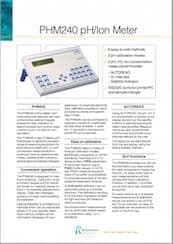
-----
How to Calibrate pH Meter or Otherwise Fix Bad Readings
Q. We have been having trouble with our desktop pH meter lately. I'm not sure if it is the heat affecting it or an electrical problem? We were having trouble with our old meter, so first off we bought a new probe, that did not seem to work, we thought we got a defective probe? So then we bought a brand new meter with a brand new probe. We're still having the same problem. We usually let the probe sit in DI when not in use, then we tried letting in soak in pH buffer solution closest to the value that we use. What it is doing is not holding the calibration, we calibrate it with a pH 4.00 buffer solution, we take one pH and it has to be re-calibrated it drops down to about 3.50 or somewhere in that area? Any suggestions?
Brian C. Gayletslock manufacturer - Scranton, Pennsylvania, U.S.A.
2005
A. I'm with you, pH meters suck. At least the one's I've used. The thing I don't like about them is that you have to calibrate before each use. You should be calibrating to two buffers, a low and a high. That could be part of the problem, and keeping the tip wet with DI water is the way to go, not the buffer solution. Otherwise, maybe you should get some advise about your particular unit from the vender you bought it from. Good Luck.

Sheldon Taylor
supply chain electronics
Wake Forest, North Carolina
A. We need more information, but here are a few observations. First of all, when you are not using the probe, you should store it in pH 4 buffer, not deionized water. When you calibrate, what other buffers do you use besides 4? If you are only using 4, then you are not calibrating the meter. What types of solutions are you measuring and what is the typical pH? How often do you use it and for how many measurements?

Jon Barrows, MSF, EHSSC
Kansas City
A. Don't store your pH probes in DI water. Try pH 4 or 7 buffer. Many of the pH meter manufacturers sell a pH probe storage solution that may be better yet.
And, never store probes in a high pH solution or buffer.

Dave Wichern
Consultant - The Bronx, New York
A. Add 1-2 drops of Conc. HCl in deionized water and leave the electrode overnight.
It is preferable to keep the glass electrode in slightly acidic solution instead of deionized water.

T.S.N. Sankara Narayanan
- Chennai, Tamilnadu, India
(ed.note: The good doctor offers a fascinating blog, "Advancement in Science" )
A. MOST pH meters are great tools, but they need to be cared for properly. Darn few are where I have worked.
A plating foreman whined about the short life of the probe and how he could never get the same pH as I did in the lab. The first reason, I found the probe in a cup if plating solution and it had been there for hours. This was a frequent happening. They tried to prove that you could control a Woods nickel tank by pH, and faulted the equipment when the pH never changed (near zero). I have seen them left out on the counter to a point that they were dry. I have seen them reuse buffers for days on end. I have seen probes with so much slime that they could not possibly work. I do not like high purity DI water for storage. Mix it with pH 7 buffer or use tap water if it is good water. Best is to buy the storage solution for that precise probe. Sometimes you luck out. We had two units that I bought for $12.50 at a bid sale - unused with a gel probe that I thought was a joke. We used one on the waste treatment line for over three years (same probe). Then we broke out the second one and it lasted for nearly as long. I work in a US government lab and I am appalled by the miss use of pH equipment. Some are PhD's.
- Navarre, Florida
![]() I would like to thank everyone for there help first off.
I would like to thank everyone for there help first off.
Q. Here is a little bit more info....hopefully this will help. On our meter we have a one point calibration we usually use that one(calibrated at pH 4.00) we do have 7.00 buffer solution and 10.00 buffer solution in the house. We mainly use the PH meter to check our Ni baths and Cr(trichrome) baths. Our lowest Ni bath is 2.00 and our highest one is 4.20 our Cr we run at 3.50. We check the Ph's first thing in the morning and then directly rite after lunch (12:30 p.m. E.S.T.) Occasionally we do check alkaline cleaners with a much higher pH but that is few and far between because we maintain our cleaners with a weekly maintenance add. For the longest time we were storing the probe in (straight) DI water,now we tried another approach with keeping it in pH 4.00 buffer solution,we change the rinse waters daily along with the buffer solution,we keep the probe clean(using 10% HCl and water) we do that once a week,and we keep the machine and the surrounding area very clean,just seems that none of this seems to be working for us.
Regards
lock manufacturer - Scranton, Pennsylvania, U.S.A.
2005
A. My setting is multi-staged wash lines for powder coating. I never let the floor have the pH meter for the reasons that Mr.Watts mentioned, I give them those pH strips that are used for swimming pools, (all the purist may frown now).
I still don't like calibrating the meter constantly(instructions say calibrate before each use), to me that means to re-calibrate it if it gets turned off or turns itself off automatically when not in use which could be several times in a (24 hr)day.
Wouldn't logic dictate that your not supposed to store the tip in a solution that has a contaminate that could influence it's function? So I'd stay with DI or RO water, or a solution sold with the meter for storage.

Sheldon Taylor
supply chain electronics
Wake Forest, North Carolina
A. You cannot calibrate a pH meter with only one buffer. You must use at least two different buffers. Preferably bracketing the range of your samples. In your case, it sounds like a pH 2.00 and a pH 4.00 will work well for most of your work. I think that you will find that your problem goes away when you calibrate properly.

Jon Barrows, MSF, EHSSC
Kansas City
Q. I see what you are saying, that you cannot calibrate with only one buffer, but ... my meter has a setting for a one point calibration, is it acceptable going that route? I have tried everyones' suggestions and nothing seems to work for me, I am starting to wonder if I am picking up interference from another machine or something of that nature; it does mention something about that in the instruction manual.
Regards
lock manufacturer - Scranton,Pennsylvania, U.S.A.
2005
A. 1 point calibration is possible on meters that set the iso-potential point electronically. This is not as correct as using a 7 buffer for that point on a two point calibration.
A wild guess! You are wiping the liquid off of the probe after use. This can impart a huge voltage (static electricity) on a piece of equipment that measures millivolts. Try just rinsing it off with a squirt bottle of clean water and shake very gently.
- Navarre, Florida
A. BRIAN !
You have pH meter problem,if your pH meter's electrical code is plug in closer to high voltage like (480 volts) area. If your pH meter have trouble to read right, try to move your pH meter away from high voltage area.

Popatbhai B. Patel
electroplating consultant - Roseville, Michigan
A. To properly calibrate you must use 2 buffers at least. The most recommended procedure is to adjust the CAL screw or knob using pH = 7 buffer. This is the so called iso-potential point. Soak thoroughly w/DI water and then immerse electrode in the second buffer, say, pH=4 for acidic solutions, when reading stabilizes, adjust the SLOPE screw or knob to pH=4 and the meter will be ready for use(If measuring alkaline solutions use pH=10 buffer instead of pH=4.). You can check immersing electrode in the pH=7 buffer again and see if the reading is correct. Otherwise meter/electrode are in bad condition or wrongly selected. Sometimes dirty/dry electrodes can be restored using the HCl solution overnight, but I wouldn't recommend this as a normal practice.
I don't know how can you calibrate using only one buffer. I am not going to get into theory of it, but measuring pH is done by correlating pH to a EMF developed in the sensor, so you must have at least two points to make this correlation. If your meter has only one point cal (no slope adjustment) then you probably should seek a better pH meter.
I doubt this is your scenario, but fluoborate nickel baths may eventually destroy a glass sensor membrane. In fact, almost any fluoride represent a hazard to glass sensors. Special electrodes should be used in such case.
As they said before, magnetic or electromagnetic fields (and I would add, incorrect grounding of equipment) can definitively affect meter operation. I've seen this before. Older equipment is more sensitive to this effect. Avoid strong magnetic fields when measuring pH.
Check out the temperature. If you calibrate at 25 °C and measure a solution of 60 °C you must allow for thermal equilibrium and compensate for temperature difference before taking the actual reading. Most newer meters have a built in or separate additional temperature sensor for compensation. If you take the hot sensor back to the cold buffer solution your pH readings obviously will not be the same until the system reaches the thermal equilibrium (this may take a minute or so).
Good luck! :-)
- Hermosillo, Son. Mexico
2005
![]() Again thanks for all your help out there I appreciate it a lot. I am actually a waste treatment guy, I do know a lot about plating but there is a lot I don't know! Mr. Watts I do not wipe the probe off, we use a freshwater rinse and then two DI rinses,they are changed daily along with the pH buffer solutions, I have been trying the three point calibration 4-7-10 but I think my problem is an electrical issue.
Again thanks for all your help out there I appreciate it a lot. I am actually a waste treatment guy, I do know a lot about plating but there is a lot I don't know! Mr. Watts I do not wipe the probe off, we use a freshwater rinse and then two DI rinses,they are changed daily along with the pH buffer solutions, I have been trying the three point calibration 4-7-10 but I think my problem is an electrical issue.
- Scranton, Pennsylvania
2005
A. This is a pretty long shot ...
A very uncommon problem associated with the use of p.H meters is due to the fact they measure very small potentials(mV). I have encountered one case where the movement of a certain solution produced a static charge to build up. This resulted in sudden changes of the readings like which you have described and was also not rectified by replacing the probe. The solution to this problem was through the use of a grounding/earthing rod introduced into the solution.. all of a sudden the p.h. meter gave a stable reading.
I know.. strange, but true ...
Regards,
- Melbourne, Vic, Australia.
2005
A. A dirty and greasy probe will be a problem in accurate and steady pH measurement. Week-end activation of the probe in 1N HCl ⇦ on Amazon [affil link] will make the probe active and measurement will be quick and steady.

Subramanian Ramajayam
consultant - Bangalore, India
January 3, 2014
Q. Why are pH meters calibrated?
EDWARD [last name deleted for privacy by Editor]student - KUMASI, GHANA
September 23, 2013
A. Hi Edward. Because there would be little point in taking pH readings if they're going to be wrong :-)
Is it possible that you didn't understand the meaning of the word 'calibrated', and that your real question is what is the meaning of that word? As a good study habit, if you are still a young student, may I urge you to please ask questions when you don't know the answer ... but don't post questions that you don't understand; rather, ask your teacher for clarification of the question. Good luck!
Regards,

Ted Mooney, P.E.
Striving to live Aloha
finishing.com - Pine Beach, New Jersey
Ted is available for instant help
or longer-term assistance.
September 24, 2013
A. Of all the misused kit in the lab or shop, the pH meter tops the list. You cannot just dunk it in and hope for accurate readings.
To use it properly requires more knowledge than I can offer in a short email; but a few points.
Calibration is a check on the electrics, usually carried out once a year by the manufacturer or a test lab.
Buffer solutions are used to standardise the instrument before each use. They must be fresh, uncontaminated and used at the specified temperature. Don't drag out buffer into the test solution or solution into the buffer. Rinse after each and touch the electrode GENTLY with the corner of a tissue to remove drops.
Electrodes are probably the most common source of error. Very high and very low pH requires specialist electrodes. Below 2 or above 9 I would generally prefer titration to pH control - remember pH is a log scale.
The glass bulb is extremely fragile and cracks can be difficult to see.
The counter electrode (often incorporated with the glass one) is filled with a special solution. It must be kept topped up and the rubber plug must have a vent hole as the solution is supposed to seep slowly. For the same reason, the porous plug must be kept clean and unblocked.
Grease on either electrode is a killer.
Store suspended in DI water or better neutral buffer. Do not rest electrodes on the bottom or let them touch any hard surface.
To give an idea of the general absence of basic understanding ---
A customer called to complain that a meter we had supplied was faulty. I asked what he observed when he buffered it. He did not understand the question until I explained about the buffer tablets in the kit. "I wondered what those were for".....so I explained
I thought the problem was solved but in half an hour he was back on the phone. Trying to avoid a 200 mile drive to sort the problem, I asked him to check the electrode for damage. "Looks good to me" was the response. As it can be difficult to see a crack in the glass, I asked if he could use a magnifier. His response was, "What glass? There is a big rubber thing on the end" I rest my case.

Geoff Smith
Hampshire, England
p.s.: I should have added: Never believe anyone who quotes pH to more than one decimal place. That is only useful in a research lab - and very few of those.
A. The following information was found on a pH manufacturers website.
"The electrode culminates in a bulb that is made of a very special glass. When a thin membrane of this glass, which is permeable to hydrogen ions, separates two solutions of varying hydrogen ion concentrations (pH), an electrical potential (voltage) is created at the glass/liquid interface. Any change in the potential of the electrode system will be due to the potential created on the outer surface of the glass membrane. The voltage output changes in proportion to the pH of the sample solution.
The pH meter registers the voltage produced at the electrode. Electronic circuitry within the meter measures voltage changes and converts the value to pH. The voltage is a linear function of pH.
After receiving your electrode and meter soak the electrode in a pH buffer 4 overnight. This will activate the electrode. When you are ready to use your system, plug the electrode into the meter rinse the electrode off in distilled water and shake off excess liquid.
STORAGE
1. Electrode should be stored in an acidic solution with a low salt content. Commercial soaking solution5 are available; see the product section at the end of this book.
2. Long term storage - If an electrode is to be stored over 2 weeks then both the refillable and gel-filled electrodes should be stored in storage solution."
 Bob Utech Benson, Minnesota |
 Ed. note: Bob is the author of: "High Performance powder Coating" on eBay or AbeBooks or Amazon [affil link] |
pH paper vs. pH meters
Q. Hello All
SUGGEST ME
1. Can anyone Distinguish [pro & cons of] pH Paper, Pen Type pH meter, digital pH meter ?
2. I want to know which one is best among all above. What are its merits & limits when tested in the high alkali solution, high acid solution, and high viscosity solution with different temperatures.
Thanks & Regards,
Process Engineer - Tumkur , Karnataka , INDIA.
April 30, 2014
A. Hi Surya. It's hard to answer your question in a non-trivial way within the paragraph or two that is appropriate for a public forum, but ...
1. pH paper is very cheap, very easy, and requires little training -- but it is also quite inaccurate ^imprecise. Still, if you search the web, you will see "white papers" by the manufacturers who claim that in certain circumstances pH paper can be more accurate than a pH meter.
2. Pen type meters tend to be cheap ($10-$25) and are disposable after a period of use. With reasonable care and one-point calibration they are probably a little more accurate ^precise than pH paper. If a rough idea of pH is sufficient, and they are used for just a month or two before disposal, they probably have some value.
3. If you need accurate ^precise pH readings, you need a laboratory grade pH meter ... but you must heed the warnings of the posters above that its accuracy will be proportional to the time you spend standardizing and properly caring for it (after studying what comprises proper care).
Regards,

Ted Mooney, P.E.
Striving to live Aloha
finishing.com - Pine Beach, New Jersey
Ted is available for instant help
or longer-term assistance.
May 2014
A. I would say that pH paper will tend to be more reliably accurate than pH meters, as the meters can slip off their calibration and tend to start giving bad readings if the electrode is too old. The indicator chemicals in pH paper will always give the same result.
However, pH paper is tremendously less precise than pH meters. Most pH paper is the full range stuff, from 1 to 14, and whatever color it changes to you're only going to be able to match within about plus or minus 1 pH unit. You can find pH paper that operates within smaller ranges if you look for it, but even then you're not going to match even a low-end pH meter, which gives you readings in tenths of a pH unit.
pH paper is good if you need a broad idea of whether a solution is acidic or alkaline, and a little bit or a lot. If you're monitoring a bath for any kind of process control, i.e., to know when you need to replenish the chemical, you really need a pH meter.
Temperature does affect the reading of pH meters. There's a formula to correct the readings. More expensive meters claim to have built-in correction, but based on experience I wouldn't count on that too much. If you need to know the straight-up pH value, pull a sample and allow it to come to room temperature. If you just need a running check of how the pH is changing over time, as long as the temperature is consistent it should be good enough.

Ray Kremer
Stellar Solutions, Inc.
McHenry, Illinois

May 29, 2014
![]() Thanks Ray. I was forgetful & sloppy in expressing myself. I understand the difference between precision and accuracy, and why the distinction is important, so I've corrected my inaccurate (not imprecise) wording, and I thank you for the reminder!
Thanks Ray. I was forgetful & sloppy in expressing myself. I understand the difference between precision and accuracy, and why the distinction is important, so I've corrected my inaccurate (not imprecise) wording, and I thank you for the reminder!
Regards,

Ted Mooney, P.E.
Striving to live Aloha
finishing.com - Pine Beach, New Jersey
Ted is available for instant help
or longer-term assistance.
May 2014
If you choose papers, I recommend the Pehanon brand. The color chart is right on each strip, so you're not wondering whether the wetness is throwing you off.

Dave Wichern
Consultant - The Bronx, New York
May 30, 2014
A. I'd like to add to a previous poster's reminder that a pH meter is only as good as the care one takes of it.
-Samples that are very hot will damage the probe, as will going from a hot sample to a cold rinse.
-Allowing the probe to sit in a high-ionic-strength very acid or very caustic solution for long can etch the bulb and should be avoided.
-Understanding the limits of cheapo pH pens to accurately read the pH of low ionic strength solutions is important.
-Storing your pH electrode dry won't help its lifespan. Keep it in a commercial storage solution, or even a diluted 4 or 7 buffer.
-Most important, always calibrate it at the time of use! And be sure to calibrate it to bracket the range of the sample you're testing... Don't just use a 7.0 and 4.0 buffer when you are going to test your detergent bath which comes in at pH 12! You might be off and not even know it!

Rachel Mackintosh
Lab Rat / WWTF - Greenfield MA
July 17, 2014
A. Hanna instruments makes a great little cheap meter called the Checker. It has two point calibration, and a replaceable electrode.

Dave Wichern
Consultant - The Bronx, New York
July 21, 2014
A. I think the obvious point that has been so far missed on this thread is that pH is a logarithmic scale.
A well calibrated meter is the only real way to gain an accurate result, other than intensive chemical analysis.
A result error factor of 10 does not, in my view, represent precision.
Hope this helps,
Regards,
Bill
Trainer - Newcastle, NSW Australia
July 27, 2014
A. I should also mention ISFET (ion selective field effect transistor) probes. No glass bulb to break, and it can be stored dry.

Dave Wichern
Consultant - The Bronx, New York
August 7, 2014
![]() Indeed you should mention it, Dave, because I had never heard of that and find it interesting -- Thanks!
Indeed you should mention it, Dave, because I had never heard of that and find it interesting -- Thanks!
Regards,

Ted Mooney, P.E.
Striving to live Aloha
finishing.com - Pine Beach, New Jersey
Ted is available for instant help
or longer-term assistance.
August 2014

Q. I am using PHM240 pH meter from meter lab and store probes in 4M KCl. I used to calibrate it with buffer 4 and 7 but now it has started giving a sensitivity error. Can anyone help to fix the problem?
Huma Hassan- Waikato, New Zealand
February 29, 2016
A. Good day Huma.
I think your problem is the storage solution. From my experience, storage solutions should have a pH of 7.
If you do not have the proper "electrode storage solution",you can use buffer pH 7.
Is your probe refillable, as potassium nitrate?
How often do you calibrate, and what is your procedure?
I rinse my electrode weekly with a soft bottle brush under hot water ( DI water rinse between all testings) and proceed to calibrate with fresh buffers and fresh storage solution. Depending on the solutions I am testing, I sometimes use a 1.0 N HCl to clean the probe of any organics that can interfere with results.
Hope this helps.
Regards,
Aerotek Mfg. Ltd. - Whitby, Ontario, Canada
A. Have you tried calibrating with new buffers?
Fauna Tester- Seattle, Washington USA
March 4, 2016
A. Huma,
If the solutions you are testing contain fluorides, and you are using a glass pH probe, you can actually etch the glass and it begins to degrade the pH probe. When this happens, you normally see a much slower response time and long calibration times.
If this is the case, you need to replace the pH probe.
- Bloomington, Indiana USA
April 7, 2016
A. Hot solutions can and will destroy pH electrodes that aren't specifically designed to take the heat -- and the ones that ARE may not be all that accurate. Read the limits of your probe and remember them before use. Solutions over 120 °F will wreck most regular glass ball probes -- sometimes immediately. Heat will also throw them out of calibration. This includes rinse water and cleaning solution. If you have a hot bath to measure such as a mid temp seal, take a sample out and let it cool before putting the probe in. Also be cognisant of thermal shock; going from an ambient rinse at 65 °F to a heated dye bath at 115 ° or vice versa is going to shorten the useful life of your probe.
I will also suggest that if you don't have a bottle of commercial electrode storage solution, to use Buffer 4. That may sound counterintuitive, but even though the acidic pH might not sound good for the electrode, it is, and the buffer solution won't damage the glass. I had a mentor back in the days when I worked in a university lab who was a PhD chemist and swore by giving the electrodes a 'shock treatment' where if they were slowing down with age, he'd go back and forth a few times between a 1 buffer and a 10 buffer to 'wake them up'. Sounded like voodoo to me but it worked more often than not.
If you suspect buildup of organics, meaning either greases and oils, or biological activity (yup you will get algae in an old storage solution!) Q-tips
⇦ on
eBay or
Amazon [affil link] with acetone
⇦ on
eBay
or
Amazon
[affil link] Flammable!
on it can be used to gently wipe the ball.
Also never let it just soak in DI water, or totally dry out.
All pH probes croak eventually and these suggestions won't make one last forever, just a little longer!

Rachel Mackintosh
Lab Rat / WWTF - Greenfield MA
April 29, 2016
A. Between measurements any glass and membrane electrodes should be kept in a solution of its own ion. It is necessary to prevent the glass membrane from drying out because the performance is dependent on the existence of a hydrated layer, which forms slowly. So the electrode should not be stored in DI (DeIonised! Means no ions in it!) Water because the H+ ions in your electrolyte will move out of your inner solution to the DI water through ceramic plug on the outer wall (this moving out of H+ ions giving you the potential difference thus reading) and the life will be shorter for the inner electrolyte.
You can prepare storage solution by making 3M KCL stabilized to 4 pH and always keep electrode in it. Since the inner electrode solution and outer are same and potential also same the electrolyte won't leach out to the storage solution and electrode life will be maximised. So never ever keep electrode in DI water since it will spoil your electrode within short time. If KCL is not available store in 4 pH and if it's not there then 9 pH. 7 pH is not recommended. But if nothing is available then keep in tap water do at least you can keep electrode moist and that should be (moist) the way electrode storage supposed to be done. If by chance if your electrode becomes dry then keep electrode overnight in 3M KCL and it will bring back probe to life. But whatever you do, with time your probe resistance will increase also the ceramic plus will be clogged and become non usable if you use it or not (there is shelf life 1-2 years)
Sanded ks- Kerala, India
March 13, 2017
Q, A, or Comment on THIS thread -or- Start a NEW Thread
